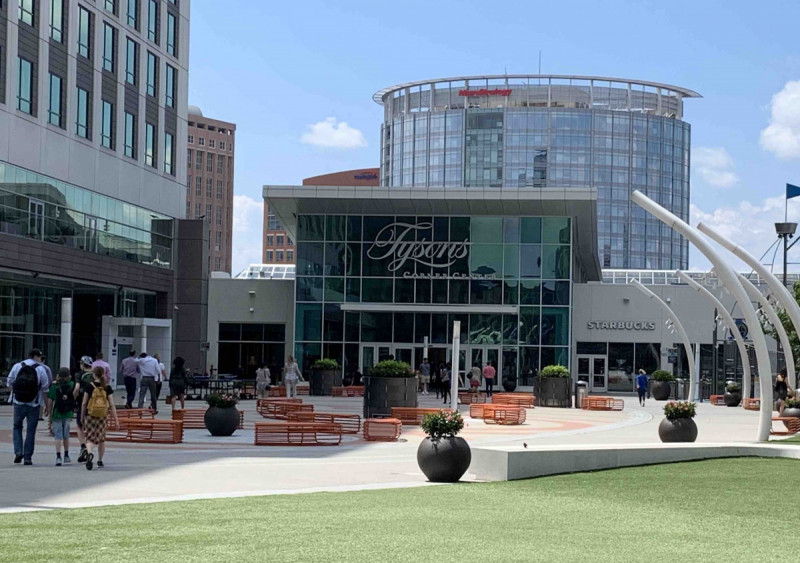Top posts of 2021: Here’s who lives in Tysons, according to psychographic market research

This was one of GGWash’s most popular articles in 2021. We’re sharing some of our hits again over the holiday season. This article was originally posted on March 12.
What kind of people live in Tysons, Fairfax County’s rapidly growing edge city? Where are they in life and what do they value? Those sound like challenging questions, the type you can guess at through Census data but never truly measure — but market researchers say they have answers.
A recent market assessment by HR&A Advisors*, commissioned by the Tysons Partnership, uses Esri’s Tapestry Segmentation system to group Tysons residents into psychographic profiles. Esri’s more than 60 profile categories include detailed descriptions of each group’s likes, dislikes, and economic situations and choices.
Psychographics are a tool used by marketers to try to get beyond demographic data to group people based on morals, values, and interests. This controversial type of market segmentation has been talked about more since scandal-ridden political consulting firm Cambridge Analytica used psychographic data to target ads for Donald Trump in the 2016 presidential election.
We should note that psychographics are qualitative in nature, and data about microtargeting methods in particular is mixed. The market assessment grouped Tysons residents into seven different market segments:
Metro Renters (30%): The largest group by far, Metro Renters make up a third of Tysons’ population, according to Esri. This group is young, educated, often single, and overwhelmingly rents rather than owns their homes.
“Residents in this highly mobile and educated market live alone or with a roommate in older apartment buildings and condos located in the urban core of the city,” Esri writes. “This is one of the fastest growing segments; the popularity of urban life continues to increase for consumers in their late twenties and thirties.”
According to Esri, Metro Renters spend a high proportion of their income on rent, clothing, and technology, and prefer to take public transportation or walk to work. Yoga, social media, and Trader Joe’s are big with this group.
Enterprising Professionals (26%): Like Metro Renters, Enterprising Professionals are highly educated and career-oriented. They are young, have high incomes, and often work in STEM, Esri says.
This group is wealthier than Metro Renters and more likely to be married, according to Esri. People in this group are more likely than the general US population to be of Asian descent. With a median age of 35, Esri says this group travels, reads digital books, and frequents the dry cleaner.
Golden Years (14%): As the name suggests, people in the Golden Years market segment are “independent, active seniors nearing the end of their careers or already in retirement.” With a median age of 52 and a third older than 65, this group is educated, financially secure, and disproportionately white.
According to Esri, people in the Golden Years category are focused on leisure activities and are often either retired or nearing retirement. They spend about 20% more on consumer goods than the national average, read newspapers, and spend time on sports like tennis, golf, and walking.
Professional Pride (9%): “Professional Pride consumers are well-educated career professionals that have prospered through the Great Recession,” Esri says. This segment is largely made up of well-off married couples living in the suburbs with school-aged kids.
Disproportionately white and with a median net worth more than five times the national median, this group overwhelmingly owns single-family homes, has a long commute, and spends a lot on home improvement.
Laptops and Lattes (8%): Esri describes this group as single, affluent, and well educated (spotting a trend here?) with a large proportion of partner couples including same sex couples.
“Laptops and Lattes residents are cosmopolitan and connected— technologically savvy consumers,” Esri writes. “They are active and health conscious, and care about the environment.”
This group is made up of image-conscious city dwellers who prefer densely populated urban areas and value environmentalism and exercise — you may not be surprised to learn that this segment dominates six of the 25 DC ZIP codes that Esri shows here.
Top Tier (7%): Yep, this is the gilded set: 7% of Tysons residents belong to the Top Tier, Esri Tapestry’s wealthiest market segment. According to Esri’s ZIP code map, this is also the segment that dominates the area of Fairfax County surrounding Tysons.
“They have the purchasing power to indulge any choice, but what do their hearts’ desire?” Esri writes. “Aside from the obvious expense for the upkeep of their lavish homes, consumers select upscale salons, spas, and fitness centers for their personal well-being and shop at high-end retailers for their personal effects.”
You don’t need us to tell you what the Top Tier spends on: vacation homes, charity dinners, luxury cars, and household services. They value fine arts and (perhaps surprisingly?) enjoy cooking meals at home.
Urban Chic (7%): Tysons’ final market segment is made up of “professionals that live a sophisticated, exclusive lifestyle.” With a median age of 43, this group is made up of white-collar professionals, have higher than average net worth, and are likely to own their homes.
So, who are the 28,000 people living in Tysons? If Esri is right, it’s largely well-off professionals who value urban amenities. Whether that will remain the case as Tysons works toward its 100,000-resident target remains to be seen.
Editor’s note: A member of Greater Greater Washington’s Board of Directors is also a partner with HR&A Advisors. Our board has no influence over editorial decisions or content.
This article was written as part of a series on Tysons previously underwritten by the Tysons Partnership and community partners. Greater Greater Washington maintains full editorial independence over its content.
